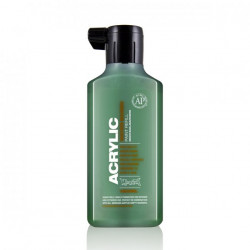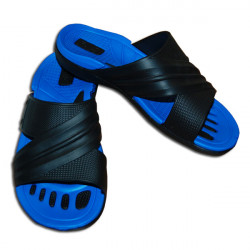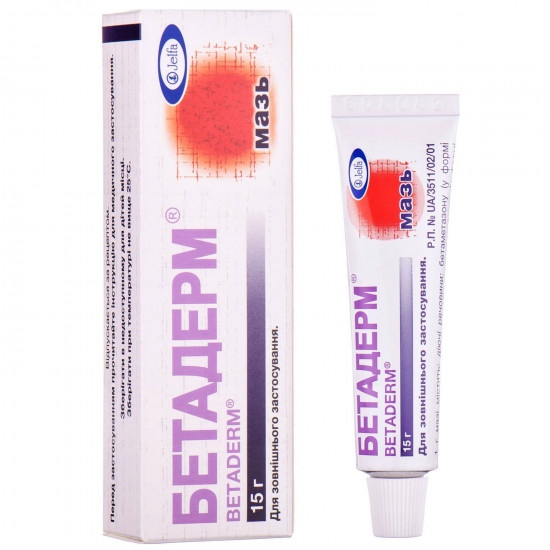
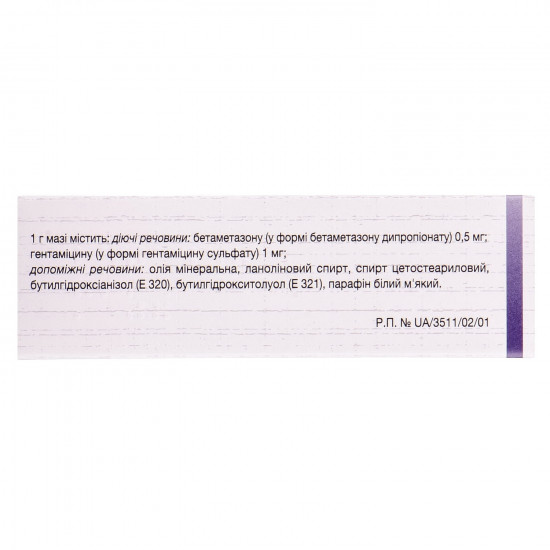
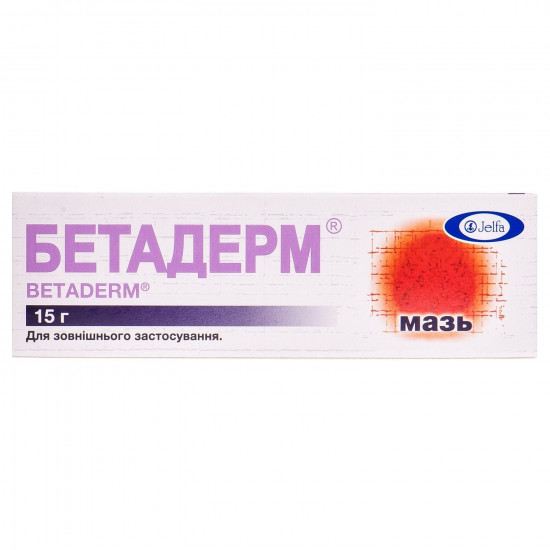





- Stock: In Stock
- Model: 178911
0% Customers recommend this product
-
5 Awesome0%
-
4 Great0%
-
3 Average0%
-
2 Bad0%
-
1 Poor0%
Reviews Over Beta dermas ointment of a tube of 15 g
- (0)
Total Reviews (0)
click here write review to add review for this product.
Report this review.
Description
Pharmacological properties
Pharmacodynamics. betamethasone Dipropionas is to the synthetic fluorinated hydrocortisone derivatives. easily gets through skin, rendering the expressed local anti-inflammatory, antipruritic and antiallergic action. removes the causes of formation of inflammatory processes, interferes with release of a histamine and emergence of local symptoms of an allergy. thanks to local vasoconstrictive effect reduces expressiveness of exudative reactions.
Gentamycini sulfas — an antibiotic of a broad spectrum of activity. It is active concerning gram-negative (proteas, colibacillus, etc.) and some gram-positive bacteria, including resistant to penicillin of stafilokokk.
Pharmacokinetics. Betamethasone Dipropionas does not biotransformirutsya in skin. After penetration through skin into an organism (absorption no more than 1%) it biotransformirutsya in a liver and it is removed mainly with urine and in smaller quantity — with bile. Dipropionas betamethasone absorption through skin increases at application on gentle skin, in the field of folds, at application on skin with the injured epidermis or on the skin injured by inflammatory process. Besides, absorption increases at frequent use of medicine and also after application on big sites of skin. Dipropionas betamethasone absorption through skin at persons of younger age is more expressed, than at adults.
Gentamycini sulfas after topical administration on the uninjured skin is not soaked up by, but after application on the skin injured by an injury, a burn and ulcers can be exposed to system absorption. Gentamycini sulfas does not biotransformirutsya in an organism and is removed with urine in not changed look.
Indication
Dermatosis responding to treatment gks at a complication or at suspicion on a complication the consecutive infection caused by microorganisms, sensitive to gentamycin: eczema (atopic, children's, monetopodobny), anogenitalny and senile itch, contact dermatitis, seborrheal dermatitis, neurodermatitis, intertriginozny dermatitis, solar dermatitis, exfoliative dermatitis, staz-dermatitis and psoriasis.
Use
to Adults and children is aged more senior than 12 years — ointment is applied a thin layer on all affected area of skin by 2 times a day — in the morning and in the evening.
Frequency of putting medicine is defined byindividually depending on disease severity. In mild cases apply 1 time a day, at the most severe defeats there can be a need for frequent application.
Duration of treatment depends on the size and localization of a disease and also on the response of the patient to treatment. If clinical improvement is not noted for 3–4 weeks, the diagnosis has to be revised by the doctor.
toContraindication
toDrug is contraindicated to patients with hypersensitivity to gks, to gentamycin or to any other component of medicine and also at a tuberculosis cutis, skin manifestations of syphilis, skin reactions after vaccination, widespread blyashkovidny psoriasis, a varicosity, perioral dermatitis, virus damages of skin, skin new growths, pink eels, youthful (ordinary) eels, chicken pox, other bacterial and fungal infections of skin without appropriate antibacterial and antifungal therapy.
not to applyon big sites of the affected skin, especially in cases of violation of integrity of skin, for example, at burns.
Side effects
Skin and hypodermic cellulose. very seldom: eels, steroid purple, oppression of growth of epidermis, atrophy of hypodermic cellulose, folliculitis, erythema, hypertrichosis, consecutive infection.
It is very rare: urticaria or spotty and papular rash, a heat rash, an itch, burning sensation, irritation or aggravation of the existing changes.
It is very rare: the xeroderma, a depigmentation or a hyperpegmentation of skin, skin decolouration, an atrophy of skin and striya at use of medicine is more than recommended term. Use on face skin can cause perioral dermatitis.
Vascular system: very seldom: at use of medicine longer than the recommended term there can be an expansion of small blood vessels (telangiectasia).
Organ of hearing. Very seldom: application on mucous membranes or on big sites of the skin which is especially injured or under an occlusive bandage, can cause ototoksichesky action because of existence in composition of ointment and cream of Gentamycini sulfas.
Endocrine system. Very seldom: hypercorticoidism symptoms. Long use of ointment on big sites of skin or under an occlusive bandage, or at children, considering the increased Dipropionas betamethasone absorption, can cause the strong system-wide action characteristic of GKS which is shown in the form of hypostases, AG, decrease in immunity, oppression of growth and development in children, a hyperglycemia, a glucosuria, development of a syndrome of Cushing.
Organ of sight. Separate cases: at topical administration on an eyelid skin medicine can sometimes cause development of glaucoma or cataract.
Immune system. Seldom: there can be a hypersensitivity to GKS, in that case use of medicine needs to be stopped immediately.
Disturbance from kidneys and urinary tract. Seldom: application on big sites of the skin which is especially injured or under an occlusive bandage, can cause nephrotoxic action because of existence in composition of ointment of Gentamycini sulfas.
Drug contains cetostearyl alcohol which can cause local skin reaction (for example contact dermatitis).
Drug contains butyl hydroxytoluene and butylhydroxyanisole which can cause local skin reaction (for example contact dermatitis) or irritation of eyes and mucous membranes.
Special instructions
not to apply without interruption more than 2 weeks
At long use of medicine on big sites of skin the frequency of manifestation of side effects and a possibility of development of resistance of bacteria to Gentamycini sulfas increases.
were Noted by cross allergic reactions with antibiotics of group of aminoglycosides.
needs to carry out byin case of development of an infection in the place of use of ointment the corresponding antibacterial or antifungal therapy. If symptoms of an infection do not disappear, it is necessary to stop use of medicine for treatment of an infection.
not to use medicament on face skin because of danger of emergence of side effects (telangiectasias, perioral dermatitis) even after short application.
needs to use with care medicament sick psoriasis as topical administration of GKS on the sites affected with psoriasis can lead to distribution of the recurrence caused by development of tolerance, risk of generalized pustulous psoriasis and the system toxicity caused by decrease in protective function of skin.
to applyOn skin in inguinal area only in case of special need as the increased absorption and high risk of development of side effects (telangiectasias, perioral dermatitis), even after short application are possible. it is careful to p to apply
at already available atrophic changes of hypodermic cellulose, especially at elderly people.
should not apply ointment under an occlusive bandage as it can cause an epidermis atrophy, emergence of striya and consecutive infection.
System absorption of gentamycin at topical administration can increase at treatment of big sites of integuments, especially at long application or in the presence of injuries of skin. In such cases the appropriate preventive measures are recommended, especially at treatment of children.
Long topical administration of antibiotics can sometimes leadto growth of resistant microflora, including mushrooms. In this case and also at development of irritation, a sensitization or superinfection, application it is necessary to stop and appoint the corresponding therapy.
Use during pregnancy and feeding by a breast
Pregnancy. Betamethasone Dipropionas is contraindicated during pregnancy.
Feeding by a breast. It is unknown whether betamethasone Dipropionas gets into breast milk after topical administration therefore it is not recommended to be applied during feeding by a breast.
Children. Drug is not used at children aged up to 12 years. Use of medicine is possible only when the expected advantage exceeds potential risk of development of side reactions. In case of application for children it is necessary to consider possibility of signs of oppression gipotalamo - a hypophysial and adrenal system which arise at children more often than at adult patients that is connected with bigger absorption of medicine at children because of a bigger ratio of the area of integuments to body weight.
At children who received GKS for topical administration, noted oppression of function of adrenal glands, Cushing's syndrome, a growth inhibition, deficiency of body weight, increase in intracranial pressure.
Manifestation of oppression of function of bark of adrenal glands: low level of cortisol in blood plasma and lack of reaction to test on stimulation of adrenal glands using medicines AKTG. Increase in intracranial pressure is shown by protrusion of the top of the head, a headache, a bilateral papilledema.
Ability to influence speed of response at control of vehicles or work with other mechanisms. Drug does not influence mental and physical activity and also ability to steer vehicles and to work with mechanisms.
byInteraction
Interactions at topical administration gks it is not revealed. however it is necessary to notice that during medicament treatment it is not recommended to do a smallpox inoculation and also to carry out other types of immunization (especially at long application on big sites of skin) because of possible lack of the adequate immunological answer.
Drug can strengthen action of immunosuppressive and reduce expressiveness of effect of the immunostimulating medicines.
Overdose
At long application on big sites of skin, in high doses, at application of an occlusive bandage, overdose symptoms which are shown by strengthening of the system side effects characteristic for gks (hyperglycemia, a glucosuria, Cushing's syndrome) can arise.
Single overdose of gentamycin did not leadto emergence of symptoms of overdose. Excessive or long use of gentamycin can lead to the excess growth of microorganisms, insensitive to an antibiotic.
Treatment. Appoint the corresponding symptomatic therapy. Symptoms of a sharp hypercorticoidism are usually reversible. If it is necessary, carry out correction of electrolytic balance. In case of chronic toxic action the gradual cancellation of GKS is recommended. In case of the excess growth of resistant microorganisms recommend to stop medicament treatment and appoint necessary therapy.
Storage conditions
At a temperature not above 25 °C. not to freeze.
Specifications
| Characteristics | |
| Active ingredients | Betamethasone, Gentamycin |
| Applicant | Baush Hels |
| Code of automatic telephone exchange | D07CC01 Betamethasone and antibiotics |
| Interaction with food | It doesn't matter |
| Light sensitivity | Not sensitive |
| Market status | Traditional |
| Origin | Chemical |
| Prescription status | According to the prescription |
| Primary packing | tuba |
| Producer | ILF A.T. PHARMACEUTICAL PLANT. |
| Quantity in packing | 15 g |
| Release form | ointment for external use |
| Route of administration | External |
| Sign | Import |
| Storage temperature | from 5 °C to 25 °C |
| Trade name | Beta dermas |
















